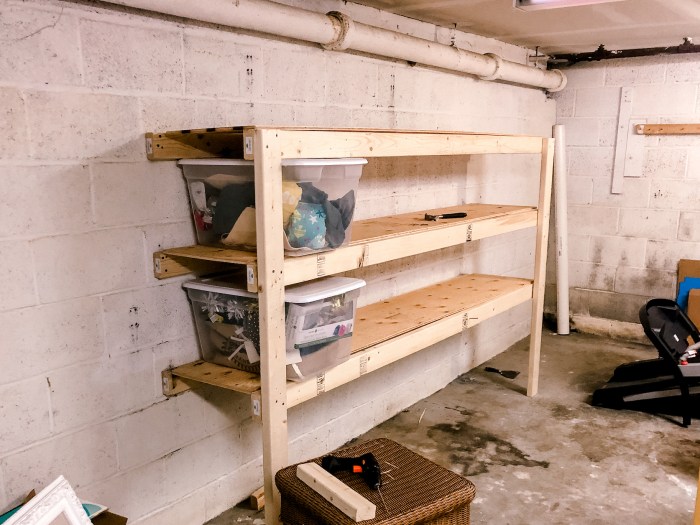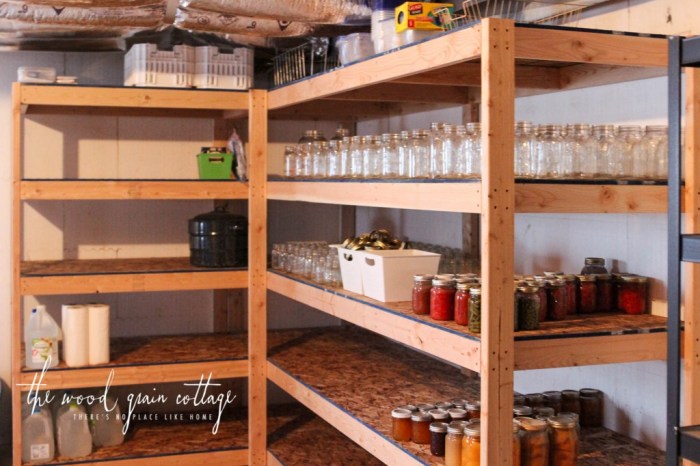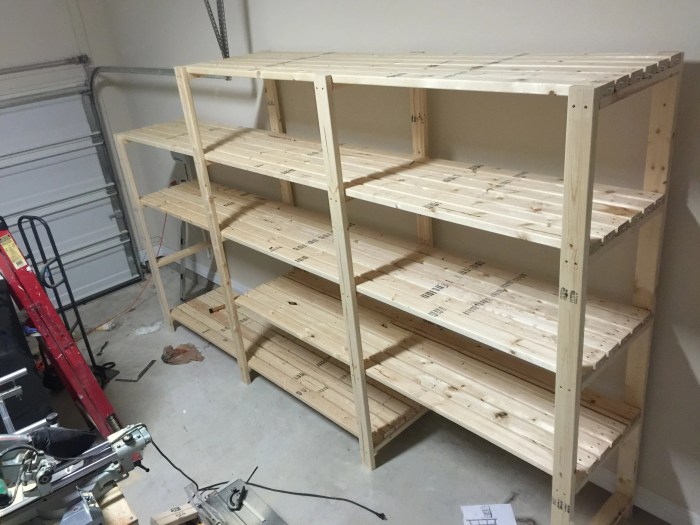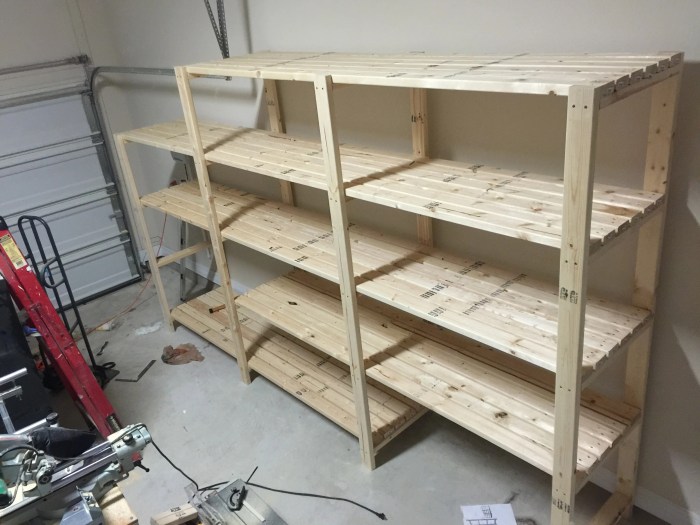DIY wood garage shelves offer a practical and cost-effective way to maximize storage space in your garage. Whether you’re tackling a home improvement project or simply seeking a way to organize your belongings, building your own shelves can be a rewarding and achievable undertaking. This guide will walk you through the entire process, from planning and design to construction and installation, equipping you with the knowledge and skills to create a custom storage system that perfectly suits your needs.
Beyond the practical benefits, building your own garage shelves allows you to unleash your creativity and personalize your space. You can choose from various designs, finishes, and storage solutions to create a system that reflects your unique style and requirements. From simple and functional shelves to more intricate designs with added features, the possibilities are endless.
Cost-Effective Solutions
Building garage shelves doesn’t have to break the bank. By implementing smart strategies and resourceful approaches, you can create a functional and organized storage system without spending a fortune.
Finding Affordable Materials, Diy wood garage shelves
Finding affordable materials is crucial for a budget-friendly project. Here are some tips:
- Check Local Lumber Yards and Salvage Stores: These often have discounted or leftover lumber, which can be a great source for shelf boards and supports.
- Consider Using Reclaimed Wood: Repurposed wood from old furniture, pallets, or even demolition projects can be a unique and sustainable option. Be sure to sand and treat it properly before use.
- Utilize Online Marketplaces: Websites like Craigslist and Facebook Marketplace often have individuals selling building materials at reduced prices.
Repurposing Existing Materials
You can save money by repurposing existing materials around your home or garage:
- Old Doors or Windows: These can be transformed into shelves, creating a rustic and unique look.
- Metal Pipes or Conduit: Use these as supports for shelves, offering a modern and industrial aesthetic.
- Plastic Storage Bins: Create shelves by stacking them on top of each other and securing them with brackets.
Cost-Saving Strategies
- Plan Your Project: Carefully measure your space and determine the exact materials you need. This will help you avoid buying extra materials and prevent waste.
- Utilize Simple Designs: Opt for basic shelf designs that require minimal cuts and hardware. Simple designs are often the most cost-effective.
- Choose Affordable Hardware: While it’s important to use sturdy hardware, you can find budget-friendly options at most hardware stores.
- DIY Approach: Building your own shelves instead of buying pre-made units will significantly reduce costs.
Advanced DIY Techniques

Taking your garage shelving project to the next level involves exploring more complex designs and incorporating additional features. This section will guide you through techniques for creating tiered shelves, corner shelves, and integrating drawers or doors into your shelving system.
Tiered Shelves
Tiered shelves offer a dynamic solution for maximizing vertical space in your garage. These shelves are designed with multiple levels, allowing you to store items of varying heights and sizes efficiently.
Here are some tips for building tiered shelves:
* Planning the Structure: Start by determining the dimensions of your shelves and the number of tiers you need. Consider the weight distribution of the items you’ll be storing to ensure structural stability.
* Choosing the Materials: Select sturdy materials like plywood or MDF for the shelf boards. Use strong supports like 2x4s or 2x6s for the frame.
* Constructing the Frame: Build a sturdy frame for each tier, using corner brackets or dado joints for secure connections. Ensure the frame is level and plumb before attaching the shelves.
* Adding Braces: Incorporate braces for additional support, especially for wider or heavier shelves.
* Finishing Touches: Sand the shelves smooth and apply a sealant or paint for durability and aesthetics.
Corner Shelves
Corner shelves effectively utilize often-unused space in your garage. They provide a compact solution for storing items that might otherwise clutter your main shelving areas.
Here’s how to build corner shelves:
* Measuring and Cutting: Measure the corner space you want to use and cut the shelf boards to fit.
* Creating the Base: Construct a triangular base to support the shelves. Use sturdy materials like plywood or MDF.
* Attaching the Shelves: Secure the shelves to the base, ensuring they are level and aligned.
* Adding Braces: Incorporate diagonal braces for extra stability.
Building Shelves with Drawers or Doors
Adding drawers or doors to your shelves provides additional storage options and enhances organization.
Here are some techniques:
* Drawers:
* Drawer Slides: Use sturdy drawer slides that can handle the weight of the items you plan to store.
* Drawer Construction: Build the drawers using plywood or MDF, ensuring they fit snugly within the shelf unit.
* Drawer Fronts: Attach drawer fronts to the drawers, ensuring they align with the shelf unit.
* Doors:
* Door Hinges: Select hinges that are strong enough to support the weight of the doors.
* Door Construction: Build the doors using plywood or MDF, ensuring they fit the opening of the shelf unit.
* Door Handles: Attach door handles or knobs for easy access.
Incorporating Custom Storage Solutions
Custom storage solutions allow you to tailor your shelves to meet specific needs.
Here are some ideas:
* Specialized Storage: Create specialized compartments for specific items, such as tool organizers, bike racks, or hanging storage for gardening tools.
* Adjustable Shelving: Utilize adjustable shelf brackets to create shelves of different heights to accommodate items of various sizes.
* Pegboard Walls: Install pegboard on the walls of your garage for hanging tools, equipment, or other items.
* Magnetic Strips: Attach magnetic strips to the walls or shelves to hold metal tools or other magnetic items.
Inspiring Examples: Diy Wood Garage Shelves

Sometimes, all it takes is a little inspiration to get those DIY juices flowing. Let’s dive into some examples of creative garage shelving projects that might spark your own ideas.
Examples of Innovative Garage Shelf Designs
Here are some inspiring examples of DIY garage shelves:
- Wall-mounted shelves with integrated tool organizers: Imagine a system where your tools are not only neatly stored but also readily accessible. Picture a wall-mounted shelf with dedicated slots for wrenches, screwdrivers, and other frequently used tools. This eliminates the need for separate toolboxes, maximizing space and organization.
- Shelving units with adjustable heights: One size doesn’t fit all when it comes to garage storage. Adjustable shelves allow you to customize the height of each shelf to accommodate items of different sizes, ensuring efficient use of vertical space. Imagine storing tall ladders or bulky equipment on lower shelves, while smaller items find their place on higher ones.
- Corner shelves to maximize space: Don’t let those awkward corners go to waste! Corner shelves are a clever solution for maximizing storage space in tight areas. Picture a set of shelves strategically placed in the corner of your garage, providing a dedicated space for items that might otherwise be difficult to store.
- Open shelving with decorative accents: Who says storage can’t be stylish? Open shelves offer a clean, modern look, and can be enhanced with decorative accents. Imagine adding a touch of rustic charm with reclaimed wood shelves, or a modern flair with sleek metal brackets. These decorative touches can transform your garage from a cluttered space into a functional and aesthetically pleasing area.
Maintenance and Care

Just like any other wooden structure, your DIY garage shelves require proper maintenance and care to ensure their longevity and stability. Taking the time to follow these simple tips will help you keep your shelves looking their best and functioning properly for years to come.
Cleaning and Caring for Wood Shelves
Regular cleaning is crucial to prevent dust, dirt, and grime from accumulating and damaging the wood.
- Dusting: Use a soft cloth or feather duster to remove dust regularly. Avoid using abrasive materials that can scratch the wood’s surface.
- Cleaning: For deeper cleaning, use a mild soap solution and a soft cloth. Wipe down the shelves gently, avoiding excessive moisture.
- Drying: After cleaning, dry the shelves thoroughly with a clean cloth to prevent moisture damage.
- Polishing: Consider applying a wood polish or sealant to protect the wood from scratches, spills, and UV damage. Follow the manufacturer’s instructions for application and frequency.
Potential Issues and Solutions
While well-built shelves can withstand the test of time, potential issues can arise over time.
- Sagging: If shelves start to sag, it could be due to overloading or weak support. Consider reinforcing the shelf supports or distributing the weight more evenly.
- Loose Joints: Over time, screws and nails can loosen, leading to unstable shelves. Tighten loose fasteners or replace them with stronger ones if necessary.
- Wood Rot: Moisture exposure can lead to wood rot, especially in humid environments. Ensure proper ventilation and promptly address any water leaks.
- Pest Infestation: Wood-boring insects can damage shelves. Inspect the shelves regularly for signs of infestation and take appropriate measures to eliminate them.
By following the steps Artikeld in this guide, you can successfully build your own DIY wood garage shelves. With careful planning, attention to detail, and a little bit of effort, you’ll be able to transform your garage into a well-organized and functional space. Remember to prioritize safety throughout the project and enjoy the satisfaction of creating a custom storage solution that meets your specific needs.
Building DIY wood garage shelves can be a rewarding project, offering a sense of accomplishment and a practical solution for storage. Just like creating a personalized storage system, taking care of your health is equally important. If you’re looking for a natural way to clear your sinuses, you might want to try nasal irrigation diy. Once you’ve tackled your garage organization, you’ll have plenty of energy to explore other DIY projects, like creating your own saline solution for nasal irrigation.

